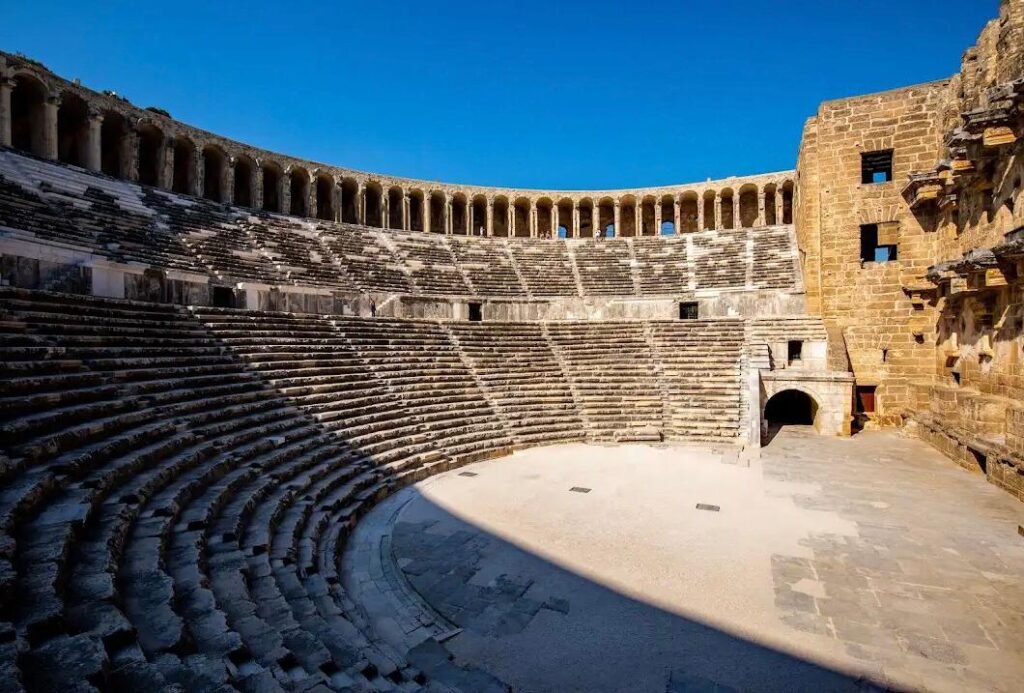Description
The Magnificent Aspendos Theatre: A Journey Through Time
Nestled in the serene town of Belkıs in the district of Serik, Antalya, the Aspendos Theatre stands as a testament to the grandeur of ancient Roman architecture and engineering. Revered as one of the best-preserved Roman theatres in the world, Aspendos continues to captivate visitors with its rich history, remarkable acoustics, and awe-inspiring architecture. This ancient site offers an unforgettable journey through time, attracting history enthusiasts, architecture lovers, and casual tourists alike.
Historical Significance
The Aspendos Theatre was constructed during the reign of Emperor Marcus Aurelius (161-180 AD) by the Greek architect Zeno, son of Theodorus. It was built to host dramatic performances, musical events, and gladiatorial contests, serving as a cultural hub for the people of Aspendos, a city renowned for its wealth and prominence in the ancient Pamphylia region.
Aspendos’ strategic location near the Eurymedon River (modern-day Köprüçay) contributed to its prosperity, as the city thrived on trade and agriculture. The theatre itself is a reflection of the city’s affluence, showcasing elaborate design and superior craftsmanship. Its exceptional preservation over centuries makes it a crucial site for understanding Roman cultural and architectural advancements.
Architectural Marvel
One of the most striking features of the Aspendos Theatre is its immense scale. The semi-circular structure spans 96 meters in diameter and can accommodate up to 15,000 spectators. The theatre’s design follows the typical Roman style, with a tiered seating arrangement that ensures unobstructed views for every audience member.
The stage building (scaenae frons) is another highlight. Standing over 20 meters high, it features intricately carved reliefs, statues, and columns. The scaenae frons originally had three stories and served not only as a backdrop for performances but also as an acoustic amplifier. The careful placement of materials and design elements demonstrates the advanced understanding of sound dynamics by Roman architects.
The theatre’s vaulted passages and staircases lead to the upper tiers, providing a glimpse into the engineering ingenuity of the time. Additionally, the use of locally sourced limestone and marble adds a distinctive character to the structure, blending seamlessly with the surrounding landscape.
Acoustics That Stand the Test of Time
The Aspendos Theatre is globally renowned for its incredible acoustics. Even without modern amplification systems, a performer on the stage can be heard clearly by spectators seated in the uppermost rows. This acoustic brilliance is achieved through the precise alignment of the theatre’s design elements, including the curvature of the seating area, the height of the stage building, and the placement of the orchestra.
Visitors often test this phenomenon by clapping, speaking, or even singing from the stage, marveling at how sound travels effortlessly throughout the structure. This remarkable feature continues to inspire modern architects and acousticians.
Cultural Revival: Aspendos International Opera and Ballet Festival
Today, the Aspendos Theatre is not just a relic of the past; it remains a vibrant cultural venue. Since 1994, it has hosted the Aspendos International Opera and Ballet Festival, attracting world-class performers and audiences from across the globe. The festival breathes new life into the ancient theatre, allowing visitors to experience its grandeur in the way it was originally intended—as a space for spectacular performances.
The combination of historical ambiance and modern artistic expression creates a unique atmosphere, making the festival a must-visit event for culture enthusiasts.
Exploring the Surrounding Area
The theatre is part of the larger Aspendos archaeological site, which includes ruins of a basilica, agora, aqueducts, and a stadium. These remnants offer insights into the daily lives and urban planning of the ancient city. The nearby aqueducts, in particular, are an engineering marvel, showcasing the Romans’ mastery in water management.
Aspendos’ proximity to the picturesque town of Serik and the bustling city of Antalya makes it an ideal destination for day trips. Visitors can explore the vibrant markets, enjoy traditional Turkish cuisine, or relax on the pristine beaches of the Mediterranean coast. For those interested in nature, the nearby Köprülü Canyon National Park offers opportunities for rafting, hiking, and wildlife observation.
Practical Information for Visitors
The Aspendos Theatre is open to visitors year-round, with extended hours during the summer season. Tickets can be purchased at the entrance or online. Guided tours are highly recommended, as they provide valuable insights into the site’s history and architectural features.
The best time to visit is during spring or autumn when the weather is pleasant and the site is less crowded. Early morning visits are ideal for photography enthusiasts, as the soft sunlight highlights the intricate details of the theatre’s facade.
Comfortable footwear is essential, as exploring the theatre and surrounding ruins involves walking on uneven terrain. Visitors should also bring water, sunscreen, and hats, especially during the summer months, to stay hydrated and protected from the sun.
Preservation Efforts
The Turkish government and various international organizations have undertaken significant efforts to preserve the Aspendos Theatre. Restoration projects have focused on stabilizing the structure, cleaning its surfaces, and maintaining its historical integrity. These measures ensure that future generations can continue to marvel at this ancient masterpiece.
Conclusion
The Aspendos Theatre is more than just a historical site; it is a symbol of the ingenuity and cultural richness of the ancient world. Whether you are an avid historian, a lover of architecture, or simply a curious traveler, a visit to Aspendos promises to be an unforgettable experience. As you stand amidst its towering arches and listen to the whispers of history, you will undoubtedly feel a deep connection to the past and an appreciation for the enduring legacy of human creativity.
Location
-
Belkıs, Aspendos Yolu, 07500 Serik/Antalya






